"A visual portrait of a Mediterranean pottery workshop, nestled in the Hebron Hills southeast of Jerusalem. Potters of Hebron focuses on the craft processes within the workshop where potters fashion the earthenware water jars, called zirs, that have been used since antiquity. Step by step we are led through the process until the craftsmen’s work is complete. The documentation of these contemporary and yet traditional craft techniques not only serves as a record of man’s artistic achievement, but also as evidence of a rapidly disappearing pre-industrial technology. Produced and directed by Robert Haber. Grade Levels: 7 to Adult"
This amazed me on several levels:
1) Of all the places in the world where they could've filmed a primitive pottery operation, they chose Hebron!
2) Of all the vessels they could've chosen for a demo, they showed the various stages of a zir, similar in overall shape to LMLK jars!
3) Although they skipped some steps in the process, they showed the pulling of handles, which look nearly identical to LMLK handles!
I particularly enjoyed the way they described the zir-process verbally, showed line-drawings of the cross-section of the various construction-stages, then showed the potter actually doing it! I will be tailoring these drawings for a chapter in my LMLK vol. 2 book, but for now I thought it would be fun to quote some narration snippets, & show a few screenshots for reference (since my book is still years away from publication).
Zir Making--A Ceramic Tradition
"The geographical situation & mild climate of the Hebron hills produce vegetables & fruits of a high standard. For centuries, grapes from this area have been prized throughout the Middle East. ... Out of the 8 pottery workshops in the valley, all the potters, with one exception, are members of a single clan (or 'hamula'), & have the same last name: Al-Fakhouri, which means 'potter'."
Note: Throughout the film, the narrator refers to the workers by their name, but in my abbreviated transcription below, I'm editing them into generic nouns & pronouns [in brackets] since I'm not sure how to spell them.
"Two types of clay are collected locally, & brought to the workshops: a red clay ('samaka'), which is high in iron, & a white clay ('kalaba'), which has a low mineral content. Each clay has its own unique properties, but when mixed together, these 2 clays make a good, even-textured material, suitable for the particular needs of these potters. 20 baskets of red clay, & 15 baskets of white clay, are thrown into the mixing tank."
"Two hours after the clay has soaked, it's become soft enough for [the potter] to mix the clay with his feet. At the same time, he feels for stones & other foreign debris, which must be removed. While churning the mixture with his feet, a scum forms on the surface. By the sense of touch alone, [he] is able to clear these impurities from the tank. [He] mixes the water vigorously so that the water is totally saturated with fine particles of clay. Grit & gravel, too heavy to mix with water, remain at the bottom."
"The clay-saturated water is then bucketed from the mixing tank into the settling tank, where the clay particles begin to settle out. When most of the mixture has been transferred into the settling tank, a passage is opened, which lets water back into the mixing tank, where the entire process is repeated. [He] can complete this process in about 2 hours. While he pauses for lunch, the mixing tank will be cleaned & refilled, so that he can repeat the process in the afternoon. It takes 7 days to fill the settling tank with fine-particled clay."
Note: One can't help but see the similarity between the process taking place in these tanks, & the remarkable pools excavated by Shimon Gibson at Kibbutz Tzuba (where he also discovered a cave he associates with John the Baptist).
"When the settling tank has been filled, approximately 50 baskets of sifted sand are added. The sand comes from Gaza on the Mediterranean coast. It serves 3 purposes:"
"First, it acts as filler to give body to the clay."
"Second, it inhibits excess shrinkage upon drying."
"And third, it serves to make the ware porous, which allows slow evaporation through the vessel wall, & keeps the contents cool."
Note: The synopsis described zirs as water bottles, but actually, it wouldn't make sense to build a porous vessel for storing water, though it would make sense if they're intended to store grains & vegetables. There's evidence that some LMLK jars were constructed to prevent such evaporation, while others did not.
"The sand is also spread on the floor of a 3rd tank, the drying tank. It acts as a separator between the wet clay, & the bottom of the tank, & allows easy removal of the clay after it's dried."
"When all the sand has been added, [they] bucket the mixture into the drying tank. During the hot summer season, it takes about 5 days for the water to evaporate, leaving a malleable clay. It's then brought inside the workshop."
"Before the clay can be used for making pots, it has to be prepared for a process called "wedging". The clay is first piled in a heap on the floor of the pottery. [He] spreads sand around the base of the pile so the clay can be easily removed after working. The purpose of wedging is to make a homogenous clay body, which is uniform in texture throughout. Midway through the process, 9-10 pounds of salt are added. The salt dissolves in the moist clay, so that after a pot has been fashioned, & as it dries, the salt is carried by the evaporating water to the surfaces. In the firing, this salt forms a fine, non-vitreous white layer. The final wedging, which prepares the clay for throwing, is done by machine. It's the only mechanical device employed in this pottery. This final wedging assures the homogeneity of each piece of clay, & removes any trapped air, which could cause the pot to explode during firing."
"The zir is made in 3 stages over a 5-day period."
"On the first day, a basic form of the zir is constructed, bottom up. The process takes about 3 minutes."
"After waiting one complete day for drying, the vessel is turned over, & placed on a support. The walls of the zir are now strong enough to allow further construction. This unique construction method is believed to be effective, & to take maximum advantage of the structural limitations of the clay. A ring of clay is separated from the thick base, now the top. It's turned over, & opened out into a flat plate, which is put on the side. The remainder of the clay is pulled up, & the walls are shaped. Next, the plate is inverted, & joined onto the top. It's again left to dry."
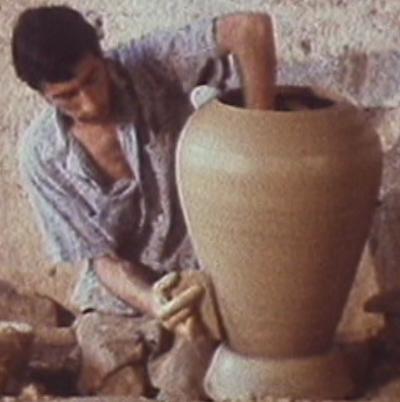
"On the 5th day, a piece of clay is shaped that will become the neck. By now, the walls of the pot are strong enough to take the weight of the neck. By a method known as "hatting", a roughly thrown bowl is inverted over the mouth of the pot, & carefully formed into the neck. After completion, handles are added to either side of the vessel."
Note: This was interesting to see that instead of merely fashioning the handle from a lump of clay, the potter cuts it from the top of a lump fashioned on the wheel:
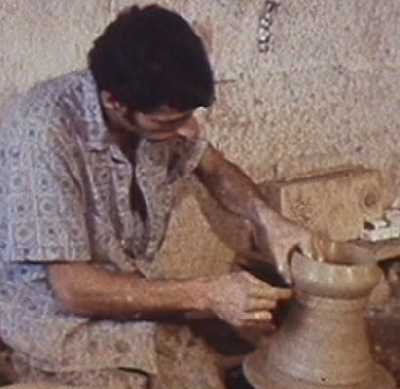
Then he cuts it, straightens it, then "pulls" it:
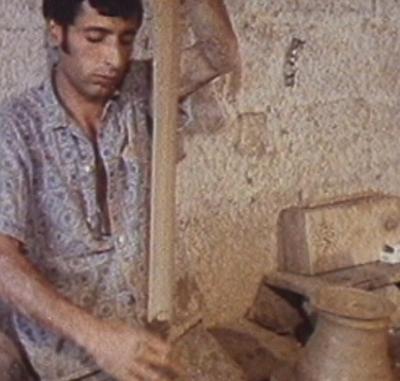
From this long strip, he pinches off small sections for each handle, which he forms, then places in a neatly arranged pile:
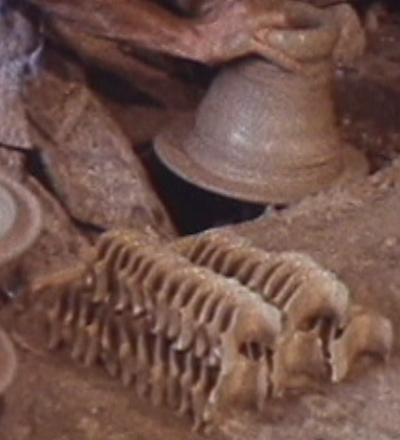
An assistant attaches the handle to the jar, in the exact same manner seen on LMLK handles (by fingerprints):
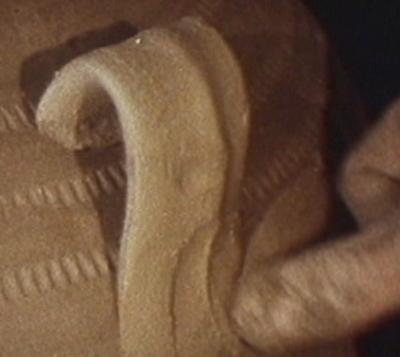
"After slowly drying for a week inside the workshop, the completed zirs are brought outside. They're then stacked in the sun with other unfired pottery. The following day, they'll be loaded into the kiln."
"When zirs are being fired, they're the first vessels to be stacked into the kiln. They're carefully placed bottom-up with smaller wares stacked in between."
Firing begins in the morning, & lasts 6-7 hours. The film concludes on a low note:
"But the encroaching world of technology, & the attraction of young people away from such a rural environment, are leading to the decline of this deeply rooted industry. This film is a record of the creative tradition. But sadly, the signs are, that the making of hand-pottery in Hebron is a dying craft."
translations by Celine Dwek & Vartoug Basmadjia
sound by Avi Cohen
music by courtesy of Folkways & Baren Reiter
graphics by Moira Mackenzie
commentary by Frank Gillard
camera by Ilan Rosenberg
assistant camera by Mickey Benyiameny
edited by Roger Guertin
produced & directed by Robert Haber
copyright by Robert Haber, 1976
encroaching-technology blog by G.M. Grena
